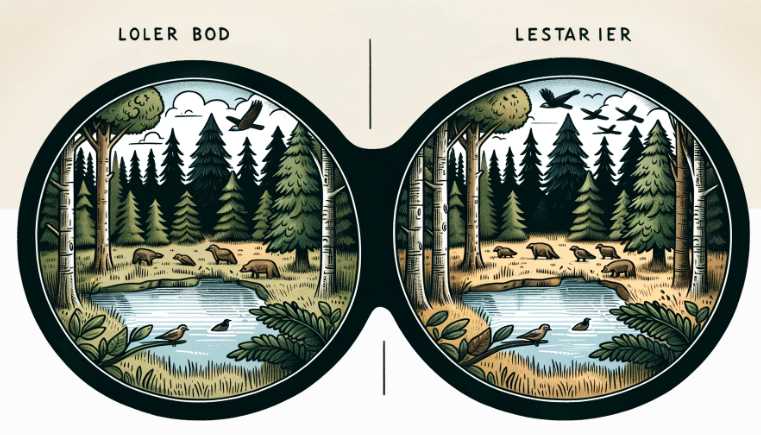For astronomy, a binocular magnification of around 7x to 10x is generally considered best. Astronomy binoculars with a magnification of 7x to 10x strike a balance between providing sufficient detail and maintaining a wide field of view. Higher magnifications, such as 15x or more, can make the image shakier and may require a tripod for steady observation. Lower magnifications, while more stable, might not reveal enough detail for certain celestial objects. The objective is to have enough magnification to observe details like lunar craters or the moons of Jupiter, while still having a broad enough field of view to locate objects easily in the night sky.
| Magnification | Characteristics |
|---|---|
| 7x | Wide field of view, stable image, good for locating objects. |
| 8x | Balanced magnification, suitable for various astronomical observations. |
| 10x | Provides more detail, but may require steadier hands or tripod for prolonged use. |
| 15x and above | Higher magnification for detailed views, but may need a tripod for stability. |

Remember that factors like the size of the objective lens and overall build quality also contribute to the performance of astronomy binoculars. It’s often recommended to prioritize optical quality, a larger aperture, and a stable mount alongside an appropriate magnification for the best astronomy viewing experience.
Choosing the Right Binocular Magnification for Astronomy

Low Magnification: Embracing the Panorama
Advantages and Best Use Cases
Low magnification binoculars, typically ranging from 7x to 10x, offer a wide field of view that captures the breathtaking panorama of the night sky. Ideal for stargazing in open areas, they excel at showcasing expansive star clusters and the luminous band of the Milky Way. My personal experience with low magnification has been akin to immersing myself in a celestial canvas, where the vastness of the cosmos becomes palpable.
Examples of Popular Low-Magnification Binoculars
| Model | Magnification | Objective Size (mm) | Field of View (degrees) |
|---|---|---|---|
| Celestron SkyMaster | 7x | 50 | 6.5 |
| Nikon Action Extreme | 10x | 50 | 6.5 |
| Orion Scenix | 7x | 50 | 8.2 |
These examples showcase popular low-magnification binoculars known for their ability to deliver a captivating wide-angle view of the celestial wonders.
Medium Magnification: The Versatile Workhorse
Versatility in Stargazing
Medium magnification, typically in the range of 10x to 15x, strikes a balance between panoramic views and detailed observations. This versatility makes them suitable for various astronomical activities, from scanning the night sky for constellations to observing the delicate details of nebulae. My astronomical pursuits have often led me to rely on binoculars with medium magnification, offering adaptability for different celestial scenarios.
Considerations for Choosing Medium Magnification
When selecting binoculars with medium magnification, it’s essential to consider factors like aperture and the specific celestial objects you intend to observe. Models with an aperture of 50mm to 70mm are well-suited for medium magnification, providing a blend of light-gathering capability and portability. These considerations ensure that your medium-magnification binoculars become a versatile companion in your cosmic exploration.
High Magnification: Zooming In on Celestial Details
Targeting Specific Celestial Objects
High magnification binoculars, typically exceeding 15x, are designed for enthusiasts who crave detailed observations of specific celestial objects. When aimed at the moon, planets, or star clusters, these binoculars reveal intricate features that might elude lower magnifications. My experiences with high magnification have been akin to unlocking a new level of intimacy with the celestial bodies, witnessing details that add a layer of awe to the cosmic tapestry.
Challenges and Considerations with High Magnification
While high magnification brings celestial details closer, it comes with challenges such as image shakiness and reduced field of view. Using a stable mount or tripod becomes crucial to mitigate these challenges and fully appreciate the finer details. Additionally, atmospheric conditions can impact the clarity at high magnifications, making it essential to choose the right moments for observing with such binoculars.
In conclusion, choosing the right binocular magnification for astronomy involves understanding the nuances of low, medium, and high magnification. Each category caters to specific preferences and celestial targets, contributing to a rich and fulfilling stargazing experience. Whether embracing the panorama, seeking versatility, or zooming in on celestial details, the choice is a personal journey through the wonders of the night sky.
Is 10×50 Binoculars Good for Astronomy?

Yes, 10×50 binoculars are generally considered good for astronomy. The 10x magnification allows you to get closer views of celestial objects, and the 50mm objective lens diameter provides a good balance between light-gathering ability and portability. This combination makes 10×50 binoculars suitable for observing a variety of astronomical objects, including the moon, star clusters, and some of the brighter planets.
Which Binocular is Best for Astronomy?
The best binoculars for astronomy depend on individual preferences and observing conditions. However, popular choices often include 7×50 and 10×50 binoculars. A 7×50 configuration provides a wider field of view, making it easier to locate objects in the sky, while 10×50 binoculars offer slightly higher magnification. Consider factors such as magnification, field of view, stability, and aperture size when choosing the best binoculars for your astronomy needs.
What is the Best Size Binoculars for Stargazing?

The best size for stargazing binoculars often falls within the range of 7×50 to 10×50. The 7×50 configuration provides a wider field of view, making it easier to navigate the night sky, while the 10×50 configuration offers slightly higher magnification for more detailed views of celestial objects. The balance between magnification, field of view, and portability makes these sizes popular choices among astronomers.
Can You Stargaze with 20×50 Binoculars?
Stargazing with 20×50 binoculars is possible, but it comes with some considerations. The higher magnification allows you to see more detail, but it also reduces the field of view, making it challenging to locate objects in the sky. Additionally, higher magnification can make the image shakier unless the binoculars are mounted on a tripod. While 20×50 binoculars can be used for stargazing, they may be better suited for specific observations rather than general celestial exploration. Consider factors such as stability and ease of use when deciding on the appropriate magnification for your stargazing preferences.
Resources and References
- “Binocular Astronomy” by Craig Crossen and Wil Tirion – Link
- This comprehensive guide offers in-depth insights into binocular astronomy, covering magnification principles and practical tips.
- “The Binocular Stargazer” by Neil English – Link
- Neil English’s work provides a user-friendly approach to binocular stargazing, helping readers navigate the night sky effectively.

I am an enthusiastic student of optics, so I may be biased when I say that optics is one of the most critical fields. It doesn’t matter what type of optics you are talking about – optics for astronomy, medicine, engineering, or pleasure – all types are essential.
Last update on 2025-10-16 / Affiliate links / Images from Amazon Product Advertising API
Table of Contents



